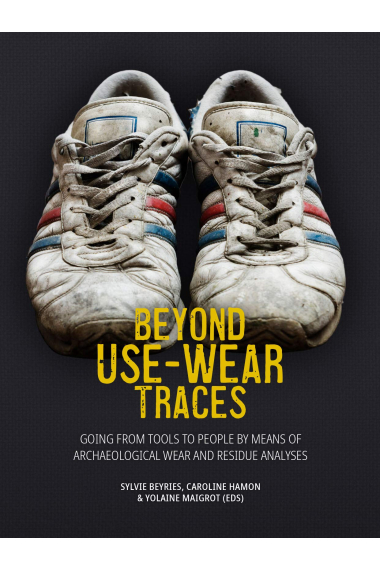
Buch Details
This book brings together 30 papers by leading scholars in the field of usewear and residue analysis. This publication aims to revive the debate on the role of traceology (use-wear and residues) in multidisciplinary approaches that address archaeological questions. Many studies on technological aspects of material culture deal with specific material categories (e.g. flint, ceramics, bone), often in separate or isolated ways, and this division does not really reflect the integrated nature of technical systems in which different material categories are in dynamic interaction. Hence, exploring the interaction between different chaînes opératoires is crucial for a more global concept of the toolkit with all its components and it is a precondition for paleo-ethnographic reconstructions of technical systems and economies. Starting from a functional perspective, the papers in this book explore various topics such as apprenticeship, group dynamics, social status, economy, technological evolution, spatial organization, mobility patterns and territories, or adaptations to cultural and environmental changes.This collection of papers, presented at the AWRANA conference in 2018, constitutes a major sign of the dynamism, popularity and scientific importance of our discipline in current archaeological research. AWRANA 2018 was dedicated to the memory of H. Keeley. Contents:PrefaceRichard FullagarIntroductionSylvie Beyries, Caroline Hamon, Yolaine MaigrotA Tribute to Lawrence Keeley through some personal recollectionsPatricia AndersonLawrence Keeley and the Archaeology of hunter-gatherer societies. A work that transcends until today?Maria Estela MansurPart 1 ? Methodologies and referentialAn attempt to better distinguish the micropolishes using visible spectroscopyRenaud GosselinExperimental protocol on shell ornaments perforation: identifying techniques and stigma variability according to the utilized speciesLeïla Hoareau, Chiara Zen, Sylvie BeyriesIn the Prehistoric kitchen with stone tools: identification of multifunctional tools through use-wear analysisEmily Tochtrop, Danielle A. MacdonaldUse-wear analysis of plant processing in the Mesolithic and Neolithic of south-east of France: the contribution of ethnographyCristina De Stefanis, Sylvie BeyriesWhat?s on the menu? An experimental approach to the functional study of Neolithic potteryPauline DebelsComparison of the use-wear traces on bone awls and styluses ? an experimental studyMonika StelmasiakStones, bones and reeds operating chains in manufacture and use of artefacts for the production of basketry in the societies of Tierra del fuegoVanessa Parmigiani, Anna Franch Bach, Maria Celina Alvarez Soncini, Hernán De Angelis, Maria Estela MansurPart 2 ? Toward technical behaviorLower Palaeolithic stone tools: a techno-functional study of the Soucy 3P assemblage (France)Juliette Guibert-Cardin, Félicien Capellari, Vincent Lhomme, Nelly Connet, Elisa Nicoud, Sylvie BeyriesExperimental archeology for the interpretation of use-wear: the case study of the small tools of Fontana Ranuccio (late Lower Palaeolithic, central Italy)Flavia Marinelli, Daniela Zampetti, Cristina LemoriniStone tool use and rejuvenation at the Late Paleolithic site of TH.413 Wadi Ribkout, southern Oman.Yamandú H. Hilbert, Ignacio Clemente-ConteMesolithic bone adzes and mattock-heads from Poland. Some suggestions on their technology and functionJustyna Or?owska, Grzegorz OsipowiczAssessing the function of trapezoidal bitruncations from Beg-er-Vil (Quiberon, France) through the use-wear methodologyJorge Calvo Gómez, Grégor Marchand, David Cuenca SolanaNew insights into the technological management of the Neolithic cowrie beads in the Levant: An experimental and traceological approachHala AlarashiFrom the quarry to the village: use-wear analysis of the manufacture of schist bracelets in the Early Neolithic of north?western EuropeCaroline Hamon, Nicolas Fromont, Eric Gaumé, Cécile Germain-ValléeA functional analysis of abrading stones: a case study from the Central BalkansVesna Vu?kovi?, Roberto RischWild boar tusk artefacts from peatbog sites of northwestern Russia and northeastern Belarus (4th-2nd mill. BC): technology, function, contextAnna Malyutina, Maxim CharniauskiFish exploitation during the Early Bronze Age Central Greece: the contribution of use-wear analysis at MitrouMarie-Philippine MontagnéTypological and functional study of few sickle inserts from Central Caucasus (according to the materials from Grakliani Hill)Ana TetruashviliLithic artifacts and the production of metallic goods. A case of study in northwestern ArgentinaErico G. Gaál, Hernán De ÁngelisFunctional analysis of metal production tools of the Late Bronze Age in Eastern UkraineOlga ZagorodniaPoints or knives? The multiple sides of bifaces at the Bahia Colorada Site, Englefield Island, Southernmost PatagoniaConsuelo Huidobro MarínPart 3 ? Building socio-economic systemThe curious case of house 54 from Lepenski Vir (serbia): chipped stone perspectiveAn?a Petrovi?, Stella Nunziante-CesaroThe Swifterbant Culture in the Scheldt valley: microwear analysis as part of integrated research into the Mesolithic-Neolithic transition in northern BelgiumEva Halbrucker, Liesbeth Messiaen, Dimitri Teetaert, Philippe CrombéTracking the function of monumental enclosures of the Middle Neolithic in France: The case of Passel ?Le Vivier? (39th century BC, Oise)Nicolas Cayol, Yolaine MaigrotInterpreting the use of living space in an Early Bronze Age village in Eastern Anatolia: use-wear and spatial analyses of macro-lithic tools of level VI B2 of Arslantepe (Malatya, Turkey)Antonella De AngelisMrowino, site 3 ? functional study of the Funnel Beaker Culture settlement of the Polish PlainJacek Kabaci?ski, Marzena Szmyt, Ma?gorzata Winiarska-Kabaci?skaTechnological strategies and activities organization the uttermost part of South America during Late Holocene: a use-wear approachMyriam Alvarez, Nélida Pal, Ivan Briz i GodinoUse-wear on bone and lithic tools to discuss functional site variability in the Paraná Basin. The Cerro Lutz archaeological site. Late Holocene, ArgentinaNatacha Buc, Romina Silvestre, Ricardo MonteroCraft identities and skill in Copper Age communities: a multidisciplinary approach to the pottery production of Central ItalyVanessa ForteFunctional study of the pre-Beaker Copper Age lithic and metallic grave goods of the Humanejos cemetery (Parla, Madrid, Spain)Maria Cristina López Rodríguez, Pedro Muñoz Moro, Carmen Gutiérrez Sáez, Raúl Flores Fernández, Rafael Garrido Pena, Ana M. Herrero Corral Biografía del autor Sylvie Beyries is Emeritus Research Director at the CNRS (UMR 7264 CEPAM, France). She works on the implementation of technical processes through a combined technology and use-wear approach. She has developed ethnoarchaeological programs in Arctic and sub-Arctic regions (Canada, Siberia), particularly in the field of hide processing.Caroline Hamon is a permanent researcher at the CNRS (UMR 8215 Trajectoires, France). She is specialized in the economies and subsistence strategies of the period spanning from the Neolithic to the Early Bronze age. Through a multidisciplinary approach (technology, use-wear analysis, anthropology of techniques), her work focuses on the economic and symbolic functions of querns and macrolithic tools in the dietary practices, craft production and exploitation of mineral resources. She has worked in different areas, from north-western Europe, to the western Mediterranean and the Caucasus.Yolaine Maigrot is a research engineer at the CNRS (UMR 8215 Trajectoires, France). She is specialized in typological, technological and traceological study of bone, teeth & antler tools. Her research interest deals with the socio-economic processes of Neolithic societies based on the analysis of their technical systems.
Mehr sehen - Schriftsteller Beyries, Sylvie / Hamon, Caroline / Maigrot, Yolaine
- ISBN13 9789464260007
- ISBN10 9464260009
- Buchseiten 414
Beyond Use-Wear Traces: Going from tools to people by means of archaeological wear and residue analyses
- Autor/in Sylvie Beyries , Caroline Hamon , Yolaine Maigrot
- ISBN 9789464260007

92,34€
97,20€
-5%
Sendung Kostenlos
Verfügbarkeit prüfen
92,34€
97,20€
-5%
Sendung Kostenlos
Verfügbarkeit prüfen
Unsere Buchhändlerinnen können die Verfügbarkeit überprüfen und dir eine Schätzung geben, wann es fertig sein wird.
 Vielen Dank für Ihren Einkauf in echten Buchhandlungen!
Vielen Dank für Ihren Einkauf in echten Buchhandlungen!

 Alibri Llibrería, Barcelona
Alibri Llibrería, Barcelona
 Librería Lé, Madrid
Librería Lé, Madrid
 Caselles Llibrería, Lleida
Caselles Llibrería, Lleida








